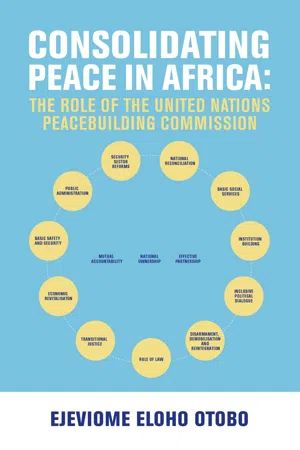
CONSOLIDATING PEACE IN AFRICA
The Role of the United Nations Peacebuilding Commission
- English
- ePUB (mobile friendly)
- Available on iOS & Android
CONSOLIDATING PEACE IN AFRICA
The Role of the United Nations Peacebuilding Commission
About this book
The decision to create the United Nations Peacebuilding Commission (PBC) was one of the major outcomes of the Summit of World leaders held in 2005 to mark the 60th anniversary of the United Nations. The Commission was inaugurated in June 2006 by Kofi Annan, the then UN Secretary-General. Today, the Commission has six countries on its agenda, all from Africa. In this book, Ejeviome Eloho Otobo, who was appointed as the first Director and Deputy Head of the UN Peacebuilding Support Office, presents an in-depth and first-hand account of the performance of the Peacebuilding Commission. The book is at once a historical record and an analytical work. As a historical account, it provides an overview of the evolution of the structure and functioning of the PBC as well as the challenges that it encountered in its formative years. And as an analytical piece, it provides rich insights into the expectations of and frustrations, with the Commission, assesses its performance in fulfilling those expectations and offers proposals on ways the performance of the Commission could be improved. The author notes that the PBC will sometimes be confronted with, and will be required to respond to, a range of crises — from political crisis to economic crisis and natural or man-made disasters — in the countries on the agenda. Reflecting on the Ebola epidemic that has afflicted three of the countries on the PBC agenda, the author offers suggestions on how the PBC should respond in such country contexts. The book also takes up one of the biggest challenges that confront countries emerging from conflict: how to tackle the challenges of institution building. This volume is highly recommended for policy makers, scholars, and students interested in postconflict transition, institution building, and the intersecting issues of peacebuilding and development.
Frequently asked questions
- Essential is ideal for learners and professionals who enjoy exploring a wide range of subjects. Access the Essential Library with 800,000+ trusted titles and best-sellers across business, personal growth, and the humanities. Includes unlimited reading time and Standard Read Aloud voice.
- Complete: Perfect for advanced learners and researchers needing full, unrestricted access. Unlock 1.4M+ books across hundreds of subjects, including academic and specialized titles. The Complete Plan also includes advanced features like Premium Read Aloud and Research Assistant.
Please note we cannot support devices running on iOS 13 and Android 7 or earlier. Learn more about using the app.
Information
Table of contents
- Cover
- Also By the Author
- Title Page
- Copyright Page
- Dedication
- Contents
- List of Tables and Boxes
- List of Acronyms and Abbreviations
- About the Author
- Acknowledgements
- Introduction
- Chapter 1: The New Peacebuilding Architecture: An Institutional Innovation of the United Nations
- Chapter 2: A United Nations Architecture to Build Peace in Postconflict Situations
- Chapter 3: The United Nations Peacebuilding Architecture: African Countries as Early Beneficiaries
- Chapter 4: Leading the Peacebuilding Commission: An Institutional History in the Making
- Chapter 5: Facts, Fictions, and Frustrations with the Functioning of the Peacebuilding Commission
- Chapter 6: Reflections on Three Important Questions Concerning the Performance of the Peacebuilding Commission
- Chapter 7: The Centrality and Challenges of Institution Building in Peacebuilding
- Epilogue
- Bibliography
- About the Book
- Index